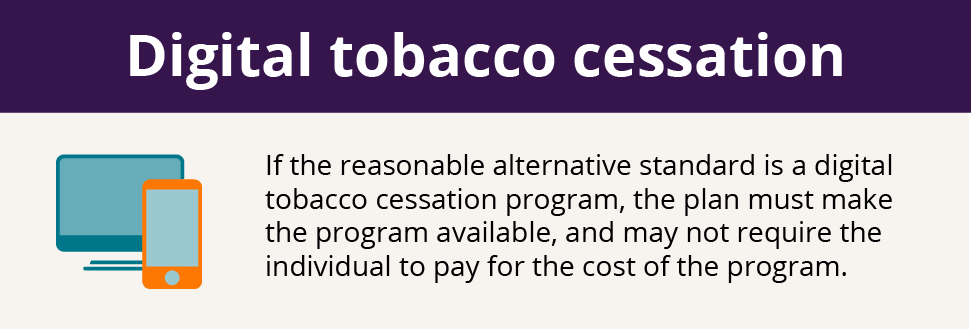If your company aims to reduce tobacco use among employees, one way it may consider doing this is by charging tobacco users more for their health insurance premiums.
Some call this difference in health insurance premium amounts a “premium differential” or a “tobacco use surcharge.”
What is a tobacco surcharge?
Under the Affordable Care Act (ACA), group health plans (and self-insured employers) can charge tobacco users up to 50% more for their health insurance premiums than non-tobacco users, and when they do this it is called a tobacco surcharge.
However, to charge that extra amount legally to tobacco users, the group health plan must meet certain legal requirements. These legal requirements include ACA, Americans with Disabilities Act (ADA), and other civil rights laws considerations.
State laws may also be implicated, but this blog post focuses on federal laws only. So before implementing any tobacco surcharges, be sure to check if your state law also adds restrictions.
ACA 5-factor test for outcomes-based programs
The ACA divides wellness program activities into 2 groups: participatory and health-contingent. Health-contingent programs are further divided between activity-only and outcomes-based programs.
In a participatory wellness program, a participant earns incentives merely by participating in the program. The participant is not expected to achieve a certain wellness goal, such as losing a certain amount of weight or having a certain blood pressure level.
That contrasts with participants in health-contingent wellness programs. In those programs, incentives are tied to achieving a health status goal, such as not using tobacco or having a certain weight or blood pressure (outcomes-based).
Incentives (such as a premium differential) tied to not using tobacco is an outcomes-based wellness program.
5-Factor Test
To legally charge employees a higher premium for tobacco use, a wellness program must meet the following 5-factor test.
 Frequency of opportunity to qualify.
Frequency of opportunity to qualify.
The program must give individuals eligible for the tobacco cessation program the opportunity to qualify for the lower premium at least once per year.
 Size of reward.
Size of reward.
The total premium difference must not exceed 50% of the total cost of employee-only coverage under the plan (or, if an employee’s family can participate in the cessation program, the premium difference must not exceed 50% of the total cost of coverage in which an employee and any dependents are enrolled). The cost of coverage includes the total amount of employer and employee contributions toward the benefit package under which the employee is (or the employee and any dependents are) receiving coverage.
Reasonable design.
The cessation program must be reasonably designed to promote health or prevent disease. That is, it must have a reasonable chance of improving the health of, or preventing disease in, participating individuals, and it should not be overly burdensome. This means that a tobacco surcharge should be accompanied with some effort by the group health plan to help tobacco users get healthy. This might be through providing follow-up information or advice designed to improve the health of tobacco using employees.
Uniform availability and reasonable alternative standards.
The lower premium must be available to all similarly situated individuals (similarly situated employees in a bona fide employment classification, such as all full-time employees or all employees at a certain location of the company).
To achieve this, health-contingent tobacco cessation programs must allow a reasonable alternative standard (or a waiver for not meeting the initial requirement of not being a tobacco user) for obtaining the lower premium for any individual for whom, for that period, it is unreasonably difficult due to a medical condition or medically inadvisable to satisfy the initial standard.
Plans may not seek physician verification for health-contingent programs. If an individual’s personal physician states that a plan standard (including, if applicable, the recommendations of the plan’s medical professional) is not medically appropriate for that individual, the plan must provide a reasonable alternative standard that accommodates the recommendations of the individual’s personal physician with regard to medical appropriateness.
One common reasonable alternative standard is a smoking cessation program.
Also, an individual must be given the opportunity to comply with the recommendations of the individual’s personal physician as a second reasonable alternative standard to meeting the reasonable alternative standard defined by the plan, but only if the physician joins in the request. The individual can make a request to involve a personal physician’s recommendation at any time and the personal physician can adjust the physician’s recommendations at any time, consistent with medical appropriateness.
As for when the lower premium to those who meet the reasonable alternative standard must be available, the plan must provide the lower premium even for the months during which the individual did not meet the reasonable alternative standard. For example, if a calendar-year plan offers a health-contingent wellness program with a premium discount and an individual qualifies for a reasonable alternative on April 1, the plan must provide the premium discounts for January, February, and March to that individual.
Plans have flexibility to determine how to provide the portion of the reward corresponding to the period before an alternative was satisfied (e.g., payment for the retroactive period or pro rata over the remainder of the year), as long as the method is reasonable and the individual receives the full amount of the reward.
In some circumstances, an individual may not satisfy the reasonable alternative standard until the end of the year. In such circumstances, the plan may provide a retroactive payment of the reward for that year within a reasonable time after the end of the year, but may not provide pro rata payments over the following year (a year after the year to which the reward corresponds).
Individuals must request the reasonable alternative standard (and they must be notified of the opportunity to make such a request, as noted later). If the reasonable alternative standard is a digital tobacco cessation program, the plan must make the program available, and may not require the individual to pay for the cost of the program. Moreover, the time commitment required for the reasonable alternative standard must be reasonable. For example, requiring attendance nightly at a one-hour class would be unreasonable.
 Notice of other means to qualify for the reward.
Notice of other means to qualify for the reward.
The plan must disclose in all plan materials the terms of a tobacco cessation program and the availability of a reasonable alternative standard to qualify for the lower premium (and, if applicable, the possibility of a waiver). This material must include contact information for obtaining a reasonable alternative standard and a statement that recommendations of an individual’s personal physician will be accommodated.
Tobacco surcharges and the ADA “voluntary” requirement
The ADA prohibits employers from discriminating against individuals based on disability or perceived disability. Discrimination under the ADA includes requiring medical examinations and making disability-related inquiries, including medical history inquiries, unless 1 of 2 exceptions applies: (1) such exam or inquiry is job-related and consistent with business necessity; or (2) the medical exam is voluntary and part of an employee health program available at the worksite. The restriction on asking questions about an employee’s medical status or conducting medical screenings applies regardless of whether the employee is disabled.
The EEOC does not consider tobacco cessation programs that merely ask employees whether they use tobacco and whether they ceased using tobacco upon completion of the program to be making “disability-related inquiries or medical examinations.”
Therefore, if a tobacco cessation program is offered through a group health plan, the ACA incentive maximum of 50% of the total cost of employee coverage applies to those programs. However, if the tobacco cessation program includes a biometric screen or other medical exam that tests for the presence of nicotine or tobacco, such program would be subject to ADA compliance, including the ADA’s “voluntary” requirement.
As a result, if a tobacco cessation program offers an incentive to test for a chemical related to tobacco use, the program must be mindful of the ADA voluntary requirement.
What does this mean exactly?
It means that any premium surcharge for tobacco use must not be so large that an employee feels forced to participate in the biometric screen. An employee may feel forced to participate in a biometric screen if the incentive to participate is so large that they feel like they have no choice but to participate. The extra money being saved by participation is impossible to pass up given their financial situation. If that is how employees feel, they may be compelled to complain to the EEOC that the company’s wellness program violates the ADA.
Health equity considerations
Studies have shown that tobacco use is more prevalent among racial/ethnic minorities and economically disadvantaged individuals. Penalizing employees who use tobacco may further disadvantage these individuals and arguably, these disadvantaged individuals may need an employer’s help the most.
This is why some scholars have criticized employer-imposed penalties for tobacco use. They contend that many smokers begin the habit before they are 18. They are therefore addicted and need help.
Employers who financially penalize tobacco users miss an opportunity to help them, which is why the ACA reasonable alternative and reasonable design requirements are so crucial in a successful tobacco cessation program.
These are just some of the legal considerations employers should explore before adopting a tobacco user surcharge. Of course, it is always wise to engage legal counsel to help craft such programs.
For more information about legal considerations with tobacco surcharges, please connect with me at Center for Health and Wellness Law, LLC.
To read additional blogs on tobacco surcharges, see Tobacco Use Surcharge Issues When Remote Employees Secretly Work in Different States, Engaging the Disengaged with Quit-smoking Incentives and Tobacco Surcharge on Health Insurance in Legal Crosshairs: Is Your Wellness Program Compliant?
**Please Note: Nothing contained in this blog post is to be construed as legal advice. This blog post is for informational and educational purposes only. Readers are encouraged to seek legal counsel for any advice or compliance determinations needed on specific situations.**


 Frequency of opportunity to qualify.
Frequency of opportunity to qualify. Size of reward.
Size of reward.


 Notice of other means to qualify for the reward.
Notice of other means to qualify for the reward.

